Menu
-
- Home
-
About Us
-
The Approach
-
Linking Language & Literacy
-
MindWing Learning
-
Learning Resources
-
SHOP
-
Blog
-
- About MindWing
- Our People
- Contact Us
- Your Account
- Login
-
Spain (EUR €)

MindWing Concepts Blog
The Incredible 5-Point Scale and Narrative Elements
April 28, 2011

April is Autism Awareness Month, and I wanted to highlight one of my favorite tools that I employ with students with autism spectrum and related disorders: The Incredible 5-Point Scale by Kari Dunn Baron and Mitzi Curtis. The 5-Point Scale is a tool designed to help students understand the confusing, emotional and language-heavy range of human behaviors by boiling it all down to a scale of 1-5. The approach is very versatile and can be applied to many situations and target behaviors, such as emotional state, voice volume or scales to help students grade their responses to everyday occurrences such as a “Participation Scale” within the classroom...
UMASS Amherst Alumna Maryellen Rooney Moreau Turns Honors Thesis Into Lifelong Pursuit
April 15, 2011
Maryellen Rooney Moreau '68 is one alumna who has turned her undergraduate thesis into a lifelong career. Over 40 years ago, Moreau completed an honors thesis on language development in the department of communication arts and sciences, which is now known as communication disorders. Her thesis prompted a continued interest in researching the link between oral language development and literacy, turning Moreau into an entrepreneur whose business has changed the way educators teach...

Two of My Favorite -ERs: ThemeMakER and GlogstER!
March 31, 2011
ThemeMaker, Mindwing’s expository companion to Story Grammar Marker, helps children break down and produce the more challenging expository text that becomes central to learning as they advance through the grades! I have found that children are more open to working with expository text once they learn that the familiar SGM icons can help them along the way! While each ThemeMaker Expository Text Map (e.g. List, Sequence, Description, Compare-Contrast) is helpful on its own, kids need to be moved toward understanding that ALL of these structures are contained in curriculum discourse and text!
That can seem like an overwhelming task, but it becomes manageable and fun using a recently developed and FREE online tool, GlogsterEDU, a site that tells all students to “poster yourself!” What is a poster, really, but a display of information that utilizes these key expository structures? Using GlogsterEDU, you can choose and research any topic with your students using ThemeMaker maps and icons, then create a “Glog” with pictures, images and graphics, text (structures!) links, and even recorded audio and video if you wish!...
The Zimmer Twins and Stepping Up Narrative Complexity!
March 17, 2011
I am going to open this post with a language sample obtained from a fifth grade student in 2006, an attempt to retell an episode of the series Full House.
And um something that happened was when this girl named Michelle and this guy Jesse, it was Michelle’s birthday. And Jesse and Michelle got stuck in a gas station and she missed her party.
And um they were there all day, but then finally it opened the next- no it opened a lot later. So um they went back to the house and they had their party and she got an elephant and she got to ride it and all her friends and she got, she felt better. And that’s it...
Using Kerpoof for Digital Storytelling and Narrative Development Part 2
March 10, 2011
Over the years I have come to believe that Story Grammar Marker has taught me as much about narrative development as it has taught my students about telling stories! Initially, I used to use the full SGM and teach Complete Episodes, regardless of my students' level of development. Although they gained a good sense of the icons and could identify story elements, the ties between elements were missing--what to do about my third graders who still peppered their stories with "and then" after "and then?" Using the “A Day in the Park” booklet with students really helped me understand my students' narrative levels and the cohesive ties that mark each stage. From there, my use of the SGM became much more thoughtful, differentiated and holistic-- addressing sentence structure as well as overall story structure.
Back to those 3rd graders- although we had done “A Day in the Park” in Grade 2, they definitely needed a review, specifically one that would boost them from an Action Sequence to a more complex story that included more mature cohesive ties: a Reaction Sequence. Their teacher welcomed me into the classroom for a group project...

Dinosaurs, Narrative, and Flexible Thinking
March 02, 2011 2 Comments

I always love finding resources that serve as a context for addressing many speech and language-related skills. The wonderful book Edwina — The Dinosaur Who Didn’t Know She was Extinct by Mo Willems is one of those resources; it can be used to target narrative and expository formulation, as well as social thinking skills in several areas.
To begin with, Edwina is a story that will engage and delight children from early to late elementary ages, beginning with its title and the name of the main character, Reginald Von Hoobie-Doobie. Reginald has a problem...
